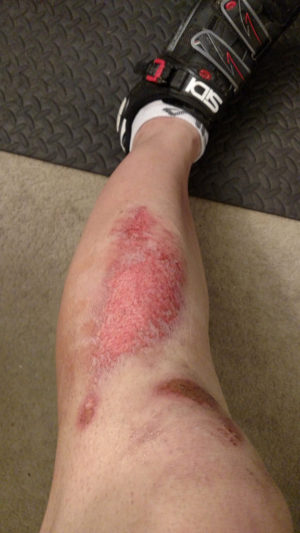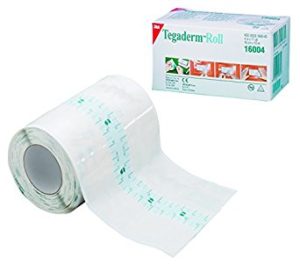You know that split second right before a wipe out, when everything slows down and you do all you can to postpone the inevitable? Unfortunately, there’s just not much that can be done in that moment other than hope for the best.
Crashes happen to the best of us, and the accompanying road rash is almost a rite of passage for many cyclists. Just think of that patch of missing skin as a symbol of your commitment to the sport and as painful as it can be, there’s no reason for it to deter you from getting back out there as soon as possible.
How should you treat road rash?
Although there has been some debate over the years as to what method of treatment is best, we’ve put together a list of tested and true steps to ensure a fast and relatively painless recovery.

Assess whole body injury
Although road rash may be the most obvious injury after a crash, it may not be the most serious. Take time to assess the whole body, including your head, spine and internal organs. If all seems to be okay, then you can assess the degree of the road rash.
If part of the wound is deep enough to need stitches, or if you can see any fat globules (white looking substance), then a trip to the hostpital is a must. If the skin is broken and bleeding, but the deep layer of skin is intact, then you should be able to treat it on your own.
Clean the wound
Halfway through a long ride, you may not have all the supplies needed to properly clean the wound if you don’t carry a first aid kit with you. First things first, gently rinse the affected area with drinking water until you can more thoroughly attend to it. Squirting the water directly from a water bottle works great to rinse away any dirt or pebbles that may be embedded in the road rash.
Once you get home, it’s time for a proper cleaning. Although scrubbing has been suggested by some cyclists, the less you aggravate the area the easier it will heal. Simply use some antibacterial soap, water and a washcloth to gently wipe the area clean before patting it dry.
Dress the wound
As a kid you may have left road rash to dry out and quickly scab over. Although this may seem like the fastest way to recovery, it often leads to scarring, an itchy or splitting scab phase and can make wearing clothes really uncomfortable. Instead, you’re going to want to keep the area nice and moist to promote healing and prevent infection.
First, apply a thin layer of antibiotic ointment to the area before covering with some sort of bandage. For mild cases of road rash, some non-stick gauze attached with tape will work just fine. For more severe cases, or for treating road rash on joints, a Tegaderm patch will be more effective as it bends and breathes like a second skin, all the while maintaining that moist environment you want for the healing process. Either way, ensure you are rinsing the wound and changing bandages daily.
Look out for infection and avoid scarring
Be sure to keep an eye on the healing process, but it is normal for road rash to take about three weeks to heal up depending on the severity. Even then, the skin will appear pink and may have a bumpy texture. We all know not to pick at the scab once it forms, so no matter how tempting it is, try keep your hands away! Keeping the area covered up and out of the sun will help avoid scarring, as well as moisturizing the area for the months following.
How to know if road rash is infected
A certain amount of bleeding and oozing is normal in the first few days after injury, but any sudden change in color or swelling may be a sign of infection. This can happen even if you were diligent with cleaning and dressing the wound, and can only be treated through doctor prescribed oral antibiotics.
Signs of infection:
- Increased pain after the first couple days
- Increase in swelling
- Red colour around the wound
- Puss or fluid drainage from the wound
- The area feels warm
Most cases of road rash are nothing to worry about, and are more of a nuisance than anything. We hope you won’t be needing this advice, but if you do take a tumble off you bike, check out “What to do after a bike crash” for more helpful information.
